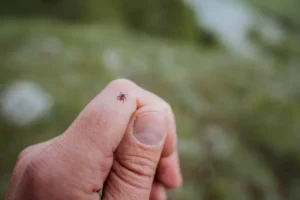 Ticks can attach to any part of the body, but they prefer warm, hidden spots like armpits, behind the ears, in joints, or in hair. They often crawl upward toward the head. After spending time in tick-prone areas, remove your clothes and use a mirror to check your body carefully for any signs of ticks.
Ticks can attach to any part of the body, but they prefer warm, hidden spots like armpits, behind the ears, in joints, or in hair. They often crawl upward toward the head. After spending time in tick-prone areas, remove your clothes and use a mirror to check your body carefully for any signs of ticks.
Ticks are sneaky. They can stay hidden even while attached! Their saliva contains an anesthetic, so their bite goes unnoticed. Once on your body, they often move to warm, dark areas, making them even tougher to find. Some ticks are as small as a poppy seed, which makes visual detection even more difficult. Spotting them takes knowing when to check, where to look, and what signs to watch for. We’ll teach you each of those steps. And if ticks have become a persistent problem around your home, it’s time to call a pest control expert for help.
When to Look for Tick Bites
Ticks in Southold are commonly found in forested spots, overgrown brush, shrubs, and tall grasses. They hunt by scaling plants near walkways and waiting patiently for a host to brush past. When you do, they hook on quickly. Their uniquely shaped legs help them grip and travel across clothing and animal fur. The longer you’re in a tick habitat, the greater the chance one will attach to you.
It’s crucial to look for ticks whenever you spend extended time outside in areas where they live. Think about after camping trips, hikes, walks in forests or tall grass, or park visits. Unfortunately, ticks may also be lurking closer to your home than you realize. Be sure to check after doing yard work or gardening, particularly in summer. Anytime you’re outside near vegetation, ticks could be present.
Where to Look for Tick Bites
Though ticks can attach anywhere, they have preferred feeding spots. They look for warm areas with strong blood flow to feed efficiently. This is why they frequently climb upward to reach your head. These hidden locations help them stay undetected longer while feeding. As a result, ticks often end up higher on your body than you’d expect.
Ticks prefer to attach to thin-skinned, warm, and hidden areas of the body, but they can hide anywhere. Common places to check include:
- Scalp
- Ankles
- Hips
- Knees
- Elbows
- Armpits
- Behind the knees
- Hair
- Under the breasts
What to Look for to Identify Tick Bites
It might seem strange, but it’s actually better if the tick that bit you is still attached. This makes it easier to locate the bite and shows it hasn’t been feeding for too long. Keep in mind that ticks are tiny, so even if you’re searching carefully, you might not spot one right away. Additionally, ticks can embed themselves deeper by burrowing partially under your skin.
Ticks on your skin often appear as tiny brown or black dots. The skin near the bite might turn red, develop a rash, swell, or become inflamed. Unlike mosquito bites, tick bites don’t usually have fluid, though they can itch. Depending on various factors, ticks may stay attached for 3 to 10 days. If you’re unsure whether it’s a tick bite, use a magnifying glass or feel for a raised bump.
Stay Vigilant: Protect Yourself from Ticks!
After spending a long time outdoors or in grassy, overgrown, or wooded areas, make sure to thoroughly check your entire body for ticks. Pay close attention to your scalp, hair, ears, neck, shoulder blades, armpits, elbows, hips, knees, and ankles. Watch for tiny black or brown spots, bumps, rashes, or swelling.
If ticks are becoming a recurring problem this summer, remember you don’t have to deal with it alone. Ticks might live close to your home, but they don’t have to stay there.
For effective tick control, contact Twin Forks Pest Control and say goodbye to these pests for good.
The Right Way to Check for Tick Bites For Your Local Pest Control Experts Serving Southold
Serving New York


